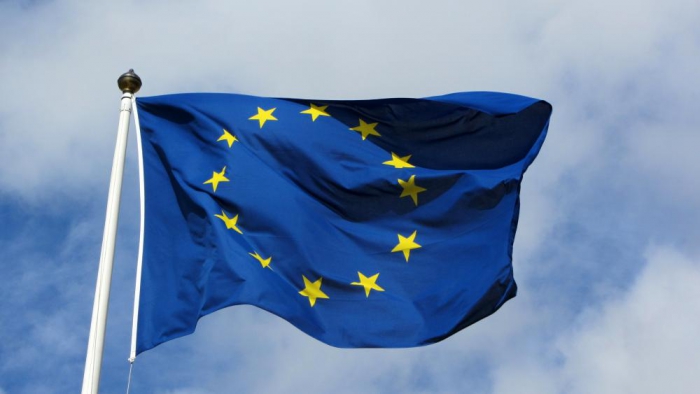Note d’actualité
Au sommet de mi-octobre de l’UE à Bruxelles, le président Macron s’est associé à la Déclaration n°52, dix ans après l’adoption du traité de Lisbonne où la France avait décidé de ne pas signer ladite déclaration.[1] Si le chef de l'Etat a fait le choix de revenir sur cette décision aujourd'hui, c’est avant tout en réponse à l’appel du leader de la France Insoumise, Jean-Luc Mélenchon, qui réclamait le retrait du drapeau européen à l’Assemblée nationale. Certes, la Déclaration n’est pas légalement contraignante, mais sa signature n’en devrait pas moins affirmer, d’après le Président,[2] « l’attachement » de la France aux symboles de la construction européenne. Sauf que la nature de cet attachement peut être très différente selon que l’on se réfère à la version française ou anglaise du texte originel.
Alors qu’en français la déclaration affirme que le drapeau, l’hymne, la devise et la monnaie européennes sont censées symboliser le « lien » des pays signataires avec l’UE,[3] son pendant en anglais parle de symboles d’« allégeance » à l’Union européenne. Lien ou allégeance, ce n’est pas pareil… Le premier suppose une relation entre sujets égaux, tandis que la seconde implique une subordination volontaire. Compte tenu de l’« horizon », tracé par le Président français,[4] qui reste délibérément flou sur la frontière entre souveraineté nationale et européenne, il n’aurait sans doute pas été inutile de clarifier au préalable cette contradiction entre les termes.

Il est vrai que voir des versions de texte européens varier selon les langues n’est pas une nouveauté. Cela s’est déjà produit à plusieurs reprises, a fortiori lorsqu’il fallait masquer, de manière subtile, des visions diamétralement opposées. La Déclaration sur l’identité européenne, signé en 1973, en est une illustration éloquente. La petite différence entre les versions anglaise et française reflète deux visions antagonistes quant aux rapports avec les Etats-Unis. Pour la France, les relations avec l’Amérique ne doivent pas influencer l’affirmation d’une politique européenne indépendante : « Les liens étroits qui existent entre les Etats-Unis et l’Europe des Neuf n’affectent pas la détermination des Neuf de s’affirmer comme une entité distincte et originale ». Les Britanniques, eux, préfèrent nier jusqu’à l’idée même d’une éventuelle contradiction entre les deux: « Les liens étroits qui existent entre les Etats-Unis et l’Europe des Neuf n’entrent pas en conflit avec la détermination des Neuf de s’affirmer comme une entité distincte et originale ». La question reste posée – tout dernièrement à propos de l’attitude à adopter par les Européens sur des dossiers aussi divers que les sanctions anti-russes, la Corée du Nord, l’Iran ou le climat.
L’acte de lancement de la défense européenne s’était articulé autour d’une confusion semblable. Suite à la Déclaration franco-britannique de Saint-Malo de 1998, c’est le placement de virgules qui a alimenté des années de débat. L’enjeu était de taille : il s’agissait de savoir si les Européens auraient le droit de prendre des décisions de façon autonome, sans avoir à obtenir l’aval de l’OTAN au préalable. Il fut entendu à l’époque que pour s’engager dans des actions militaires, l'UE devait d’abord s’assurer que l’Alliance n’était pas engagée sur le même terrain. Or, avec la disparition d’une virgule dans la version anglaise, cette restriction, que l’on nommait alors le droit du premier refus de l’OTAN, semblait s’appliquer plus généralement au pouvoir de décision des Etats membres : l’Union européenne devait être dotée de structures appropriées « pour pouvoir prendre des décisions et approuver des actions militaires lorsque l'Alliance en tant que telle n'est pas engagée ». En français, deux virgules veillaient à ce que les deux aspects restent soigneusement séparés (« pour pouvoir prendre des décisions et, lorsque l’Alliance en tant que telle n’est pas engagée, pour approuver des actions militaires »). Aujourd’hui, c’est la version française qui prévaut : les textes officiels parlent du « respect de l’autonomie décisionnelle des deux organisations ».
Les petites « erreurs de traduction » peuvent révéler des divergences d’approche géopolitique. Ce fut notamment le cas de la Stratégie européenne de sécurité, adoptée par les gouvernements de l’UE en 2003. Par rapport à la version française laquelle soulignait fermement que « même à l’ère de la mondialisation, la géographie garde toute son importance », la version anglaise semblait relativiser celle-ci, en affirmant simplement que « la géographie est importante encore ». La nuance ne prend tout son sens que dans la pratique, lorsqu’il s’agit de priorités d’action et d’hiérarchie. En effet, entretemps, on assiste partout à la « revanche de la géographie », pour reprendre le titre d’un ouvrage de Robert D. Kaplan.
Ce qui nous ramène directement au président Macron : si la petite discordance entre les versions française et anglaise de la déclaration sur les symboles de l’UE n’est pas anodine, c’est parce qu’elle dénote deux options radicalement différentes pour faire partie l’Union européenne, des options entre lesquelles le chef de l’Etat se refuse de trancher. Or l’ancien ministre des Affaires étrangères Hubert Védrine avait prédit dès 2002 que le moment viendrait où ce choix ne pourrait plus être différé : « De deux choses l'une : ou bien nous acceptons, parce que nous estimons que l'ambition européenne prévaut sur toutes les autres ou parce que nous jugeons que le cadre européen est désormais le seul qui nous permette de défendre nos intérêts, de nous fondre progressivement dans cet ensemble. Ou bien, considérant que nous ne pourrons pas préserver avec 9 % des voix au Conseil, 9 % des membres du Parlement, un commissaire sur 25, des positions et des politiques que nous jugeons fondamentales, nous refusons ce saut. »[5] Ce n’est pas qu’une « simple » question de drapeaux.
***
[1] Les citoyens français avaient rejeté par référendum, en 2005, le Traité établissant un Constitution pour l’Europe, lequel fut ensuite rebaptisé et remanié, avec des modifications minimes, pour devenir le traité de Lisbonne. Les symboles quasi étatiques ont été enlevés du texte principal et ajoutés sous forme d’une simple Déclaration, signée sur une base volontaire par 16 Etats membres. Les symboles en question sont « le drapeau représentant un cercle de douze étoiles d'or sur fond bleu, l'hymne tiré de ‘l'Ode à la joie’ de la Neuvième symphonie de Ludwig van Beethoven, la devise ‘Unie dans la diversité’, l'euro en tant que monnaie de l'Union européenne et la Journée de l'Europe le 9 mai. »
[2] Déclaration de M. Emmanuel Macron, président de la République, à son arrivée au sommet européen de Bruxelles, 19/10/2017.
[3] Déclaration relative aux symboles de l'Union européenne, Déclaration n°52 de l’Annexe au Traité de Lisbonne, Journal Officiel, 17 décembre 2007.
[4] Discours du président Macron à la Sorbonne, 26 septembre 2017.
[5] Hubert Védrine, Europe : avancer les yeux ouverts, Le Monde, 27 septembre 2002.
Tags:
france, ue





















